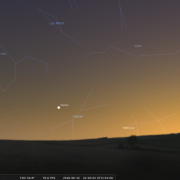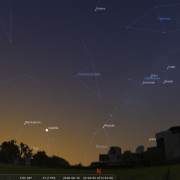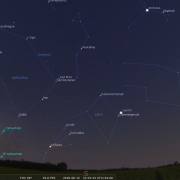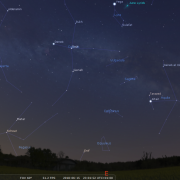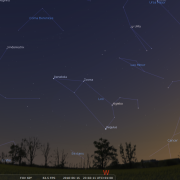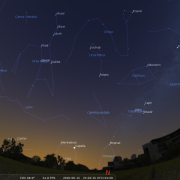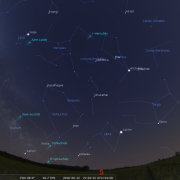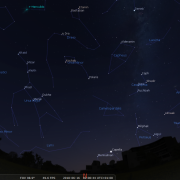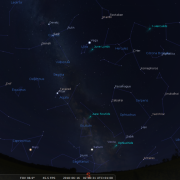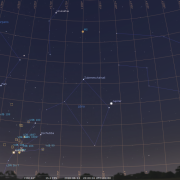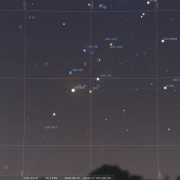Welcome to the WDAS monthly newsletter for June 2018: a digest of the month's latest contributions to our website. Below you'll find Society News, Sky Notes, the latest in Mark's monthly Crossing the Line series, as well as coming events.
Society News
After a three year break Paul returned to Whitby to give the presentation he was due to give last year, but had to pull out due to family illness. For once his trip was less susceptible to the worst of the weather, yet despite being a settled warm weather period, Mother Nature still tried to rain on our parade, but i think we got away with it.
Paul arrived in good time at the college, which was utilised marrying up his IT equipment with the IT system in the main hall... we eventually won. There was then just time to show Paul the observatory and take some pictures, something we had been meaning to do for quite a few years. Paul was delighted to see the Cooke refractor, and took quite a few pictures himself.
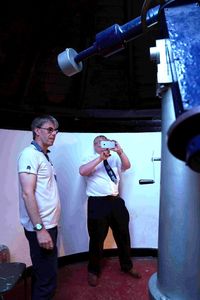
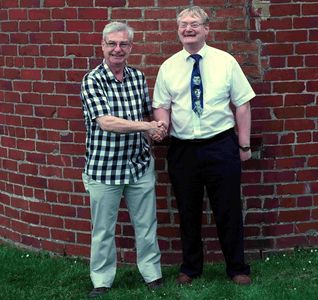
Mark and Paul in Whitby Observatory, Andy Lawrence and Paul outside it.
The venue – the main Hall at the college, had been kindly offered for our use – many thanks to them and society member Keith – who works at the college in making this happen.
By 19:30h Paul was ready. It was great to see so many members, both past and present come along for Paul’s presentation, and there were a healthy number of non society members, some of whom expressed an interest in joining.
Paul’s talk was entitled "Triumphs of Voyager – Journey to Jupiter and the splendours of Saturn"
Paul explained that as far back as the 1960’s the maths was worked out showing how a spacecraft could be dispatched to the outer planets using planetary gravity assists. A window of opportunity would be available during the latter seventies, and would not occur again for another 176 years.
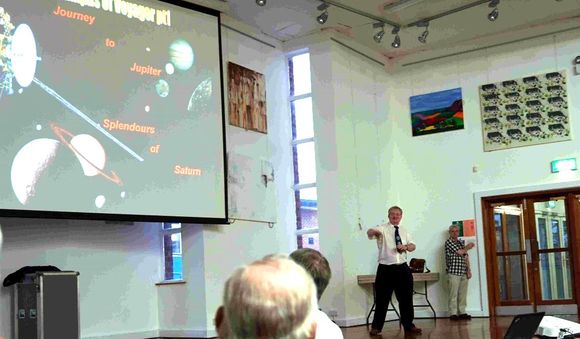
Paul giving his lecture on the Triumphs of Voyager
Eventually, NASA secured funding for the Mariner/Jupiter Saturn project, which became the Voyager missions, launching two craft: Voyager 1 and 2 in 1977. Voyager 2 was actually launched first in August, followed a month later by Voyager 1.
Voyager 1 was to fly by Jupiter and onto Saturn – passing its primary target Titan at close range. Voyager 1 would then leave the solar system (in a very long time) Voyager 2 following on the heels of 1 would visit Jupiter, then Saturn and onto the outer gas giants of Uranus and Neptune. (that’s part two of Paul’s talk on the voyages)
It was fascinating to learn how engineers were able to maintain contact; solving problems connected with trajectory motors and scientific payload arms en route. Paul showed a number of images of Jupiter and the Galilean moons, including the erupting volcanic world of Io, something which totally confounded planetary scientists. It was the ‘unexpected’ discoveries made by Voyager which revolutionised thinking of planetary satellites in particular, and paved the way for the spectacular successes of the Galileo and Cassini missions later on.
Our customary refreshments break almost didn’t happen, problems with Kitchen access, missing cups, plates, and saucers could have scuppered supper, fortunately matters were resolved and the delicious sausage rolls, homemade cheese scones and micro pizza squares made by Mark’s wife Vicky were pretty much cleaned out. A big ‘thank you’ also to Rosy, who had travelled over from Kirbymoorside, and aided admirably during the refreshment break.
The talk concluded with some stunning images of Saturn and its major moons; including an enhanced image of Enceladus in which if you looked carefully the now famous water jets could be made out, something missed at the time. Questions and answers followed, before we thanked Paul once again and hoped to see him next year, a date already tentatively pencilled in.
Thanks again to everyone who came along – hope to see you next year... if not sooner.
The summer star party season is now upon us, and with the good weather mostly holding several events have already been held on the cliff. The first was an unscheduled event for the May bank holiday Sunday, and proved quite successful. Warm temperatures and clear skies made it a pleasurable evening with Venus and Jupiter being the chief targets. The scheduled event on the 19th also went ahead, and with the added bonus of a crescent moon, a pretty eclectic, cosmopolitan and multinational gathering enjoyed views of Venus and Jupiter as well. It did get dark enough (just) to point out some of the brighter stars....aahh, the light nights are here!
The event scheduled for the bank holiday Saturday on the 26th fell victim to the low cloud, which after a fine day spilled in off the sea during the evening making any observations impossible. Any rescheduled attempt the following evening, would, after another glorious day, have suffered the same fate. You can’t win them all.
If you can join us for any of the scheduled ‘star party’ events, it would be most appreciated... (especially if you can bring a telescope along)
Sky Notes
In this month's Sky Notes:
Planetary Skylights
 At magnitude - 4.1 Venus continues to dominate the North-West twilight sky and is joined by a slim crescent moon in earthshine on the 16th. Over the course of June, Venus travels sideways more to the west from the WNW, not setting until after 23:00h. Telescopically (or indeed through any optical aid) Venus is dazzling, but if you view in bright twilight you will detect its phase, which is currently around half, nothing else will be seen.
At magnitude - 4.1 Venus continues to dominate the North-West twilight sky and is joined by a slim crescent moon in earthshine on the 16th. Over the course of June, Venus travels sideways more to the west from the WNW, not setting until after 23:00h. Telescopically (or indeed through any optical aid) Venus is dazzling, but if you view in bright twilight you will detect its phase, which is currently around half, nothing else will be seen.
 From mid June, Mercury arcs low into the North-West twilight sky slowly moving westwards until mid July. Look for a reasonably bright ‘star’ 45 minutes after sunset (22:15-22:30h) below and well to the right of Venus not far above the horizon. A flat, unobstructed view will be required, initially using binoculars to help pick out this elusive world. Once spotted you should be able spot it with the naked eye.
From mid June, Mercury arcs low into the North-West twilight sky slowly moving westwards until mid July. Look for a reasonably bright ‘star’ 45 minutes after sunset (22:15-22:30h) below and well to the right of Venus not far above the horizon. A flat, unobstructed view will be required, initially using binoculars to help pick out this elusive world. Once spotted you should be able spot it with the naked eye.

 Opposite Venus, Jupiter dominates the South-East sky and unlike Venus is a great telescopic target. Look for the Galilean moons (usually 2, 3 or 4 visible) strung out in line with Jupiter’s bands. Notable features and satellite events to look out for include – great red spot visible on the 2nd, 5th, 7th, 12th, 14th, 17th, 19th, 24th, 26th and 29th. Io shadow on disk visible on the 1st, 24th . Europa shadow transit on the 6th. There are unusual configurations of moons on 15 & 28th and finally Io disappears behind Jupiter at 22:30h on the 16th. All timings are for around 23:00h. Our Moon resides above Jupiter on the 23rd
Opposite Venus, Jupiter dominates the South-East sky and unlike Venus is a great telescopic target. Look for the Galilean moons (usually 2, 3 or 4 visible) strung out in line with Jupiter’s bands. Notable features and satellite events to look out for include – great red spot visible on the 2nd, 5th, 7th, 12th, 14th, 17th, 19th, 24th, 26th and 29th. Io shadow on disk visible on the 1st, 24th . Europa shadow transit on the 6th. There are unusual configurations of moons on 15 & 28th and finally Io disappears behind Jupiter at 22:30h on the 16th. All timings are for around 23:00h. Our Moon resides above Jupiter on the 23rd
 Saturn starts to appear in the late evening sky from the 20th onwards, and comes to opposition on the 27th, the same night the moon lies off to the left, it is also close by on the 1st. Look for a pearly ‘star’ low to the South-East from 22:30h onwards. The ring orientation is currently very favourable and any modest telescope should reveal them, but do be patient, waiting for those steady ‘seeing’ interludes in the often turbulent air in which Saturn resides. The tiny speck close by Saturn will be its chief moon Titan, which orbits round in 16 days.
Saturn starts to appear in the late evening sky from the 20th onwards, and comes to opposition on the 27th, the same night the moon lies off to the left, it is also close by on the 1st. Look for a pearly ‘star’ low to the South-East from 22:30h onwards. The ring orientation is currently very favourable and any modest telescope should reveal them, but do be patient, waiting for those steady ‘seeing’ interludes in the often turbulent air in which Saturn resides. The tiny speck close by Saturn will be its chief moon Titan, which orbits round in 16 days.
 Mars is now brightening quite rapidly, with the red planet technically becoming an evening object on the last day of June. Look for it well to the left of Saturn (post midnight for much of the month) low above the South-East horizon. Telescopically Mars appears smaller than you would expect as it nears opposition at the end of next month, but some surface detail will be discernable through more modest scopes, given steady seeing that is. The moon resides to the right on June 3rd and again on July 1st.
Mars is now brightening quite rapidly, with the red planet technically becoming an evening object on the last day of June. Look for it well to the left of Saturn (post midnight for much of the month) low above the South-East horizon. Telescopically Mars appears smaller than you would expect as it nears opposition at the end of next month, but some surface detail will be discernable through more modest scopes, given steady seeing that is. The moon resides to the right on June 3rd and again on July 1st.
Meteors

There are no major – or even semi major - meteor showers in June. There are a couple of minor showers; the Ophiuchids and June Lyrids. The former has two maxima, June 9th and June 20th, but peak rates barely reach sporadic levels (around 5 per hour). The same can be said about the June Lyrids which peak on the 15-16th. You will be extremely fortunate to spot any meteors belonging to these showers before midnight – which realistically leaves a couple of hours post midnight. Ophiuchus will occupy the area of sky low to the south, whilst Lyra is located high to south during the early morning hours. Moonlight will interfere somewhat for the June 20th peak.
The Summer Solstice
The Summer Solstice in the Northern hemisphere falls on June 21st, when the Sun reaches its greatest altitude in the sky on the ecliptic; the path it takes across the sky during a year. Within a couple of weeks the Sun start to retrace its steps southwards, as the axial tilt of Earth begins to shift away from it once again.
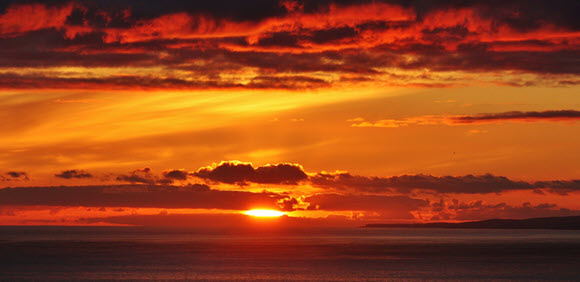
Summer Solstice. Image Credit: Ronnie Robertson
It is surprising how many people wrongly assume that Earth is closer to the Sun at this time of year; in fact the opposite is true. Earth is actually furthest from the Sun on July 4th at almost 95 million miles (153 million km), nearly 3 million miles more than when at its closest approach in early January. It is the inclination of the northern hemisphere towards the sun which causes days to ‘grow longer’ and feel warmer due to the higher concentration of sunlight per unit area. Think of this as being like a spot light directed onto to the palm of your hand, your palm feels hotter under direct radiation, whereas when the light is tilted, the angle reduces the heat intensity. The actual intensity of solar radiation in June is equivalent to approximately 1.2KW of heat for each square metre, although sometimes it feels as if someone’s forgotten to feed the meter.
Although known as the longest day, earliest sunrise and latest sunset times do not occur on the summer solstice date. Earliest sunrise falls around June 16th (from Whitby: 04:25h) whilst latest sunset occurs on June 25th (Whitby: 21:42h). It is the duration of useable daylight which reaches a maximum on the 21st, at just over 17 hours, with a meagre 4 hours of semi darkness.
Noctilucent Cloud
With bright twilight persisting well into the night, throughout June and into the July, watch out for the beautiful type of cloud formation seen only at this time of year known as noctilucent cloud. These delicate formations appear above the northern horizon, long after sunset, often around midnight. Shining quite brightly, noctilucent cloud is filamentary in structure, having a characteristic silvery-blue colour. It forms almost exclusively between latitudes 50 and 60 degrees north, high in the upper atmosphere: 50 miles up- five times higher than normal clouds.
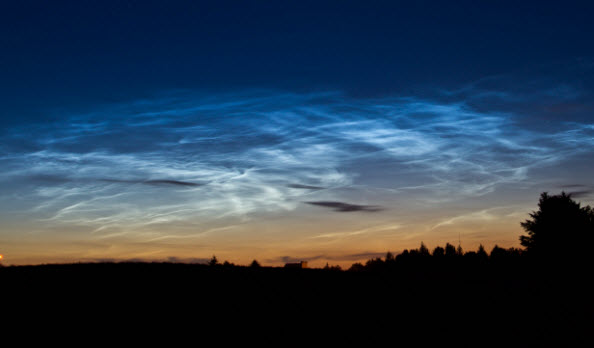
Noctilucent Cloud. Image Credit: NASA
It is thought that this type of cloud forms when water vapour condenses at the low temperatures that prevail at such altitudes onto particles suspended in the air. More frequent sightings of noctilucent cloud over the last half century may indicate that these particles could be a result of industrial pollution, perhaps from increased air traffic. Do keep watch!
|
Looking North
Mid-June - 23:00h |
Looking South |
|
Looking East
Mid-June - 23:00h |
Looking West
Mid-June - 23:00h |
|
Northern Aspect
Mid-June - 23:00h |
Southern Aspect
Mid-June - 23:00h |
|
Northern Aspect
Mid-June - 02:00h |
Southern Aspect
Mid-June - 02:00h |
Additional Image Credits:
- Planets and Comets where not otherwise mentioned: NASA
- Sky Charts: Stellarium Software
In our tour of stellar objects crossing the meridian line this month: two large compact spherical star clusters of old stars in the outer regions of a galaxy, also known as 'Globular Clusters'.
Globular Cluster: M5 (or NGC 5904)
Telescope (min. 4" diameter to see individual stars), Easy
M5 can be located in the constellation Serpens. Discovered by Gottfried Kirch in 1702, when he was observing a comet, Charles Messier noted it in 1764, but thought it a nebula without any stars associated. William Herschel was the first to resolve individual stars in the cluster in 1791, counting around 200.
With an apparent magnitude of 6.65, M5 can be spotted with the naked eye from extremely dark locations with good conditions near the star 5 Serpentis. Binoculars or small telescopes will clearly identify it as non-stellar.
M5 resides just less than 25,000 light years from Earth within the Milky Way’s galactic halo. Spanning approximately 165 light-years in diameter, M5 is one of the largest known globular clusters. The gravitational sphere of influence of M5, (i.e. the volume of space in which stars are gravitationally bound to it rather than being torn away by the Milky Way's gravitational pull) has a radius of some 200 light-years. Estimates put the number of stars within the cluster around 300,000 of which the brightest have an apparent magnitude of +12.2. At 13 billion years old, M5 is also one of the eldest globular clusters in the Milky Way Galaxy. Aastronomers have spotted many young, blue stars in this cluster, hiding amongst the much more luminous ancient stars. Known as blue stragglers, astronomers think they were created either by stellar collisions or by the transfer of mass between binary stars.
The cluster can be found about a fist-width to the north of Zubeneschamali, the brightest star in the constellation Libra. Individual stars will only appear in larger telescopes, starting with 4-inch instruments, which reveal the cluster’s brightest stars. The best time to observe M5 is in April, May and early June. M5 crosses the 180 degree meridian line – due south at 23:00h on June 11th.

Globular Cluster: M4 in Serpens ('The Serpent')
(Image Credits: This image: Hubble/NASA, Teaser/Homepage image: Robert J. Vanderbei)
Globular Cluster: M4 (or NGC 6121)
Telescope, Easy
M4 is located in the constellation of Scorpius, 1.3 degrees west of the bright star Antares. It was discovered by Philippe Loys de Chéseaux in 1745 and catalogued by Charles Messier in 1764 and was the first globular cluster in which individual stars were resolved. It lies at an approximate distance of 7,200 light years from Earth and along with NGC 6397 are the closest globular clusters to Earth. M4 has an apparent magnitude of 5.9 and is conspicuous in even the smallest of telescopes as a fuzzy ball of light. Because it lies just west of Antares, M4 is one of the easiest globular clusters to find, with both objects being visible in a wide-field telescope. Most amateur sized telescopes will begin to resolve individual stars, of which the brightest in M4 are of apparent magnitude 10.8. If it weren’t obscured by clouds of dark interstellar dust, the cluster would appear far brighter.

Globular Cluster: M4 in Scorpius ('The Scorpion') (Image Credit: Dan Crowson)
M4 is a rather loosely concentrated being 72 light years in diameter. This means that within a sphere of 142 light years centered on M4, stars can’t escape the cluster’s gravitational influence. The cluster has an orbit that takes it through the Milky Way’s disk bringing it to within 17000 light years of the galactic nucleus. As a result, M4 undergoes tidal shock, which in turn results in the loss of stars. The cluster has an estimated mass of 100,000 solar masses
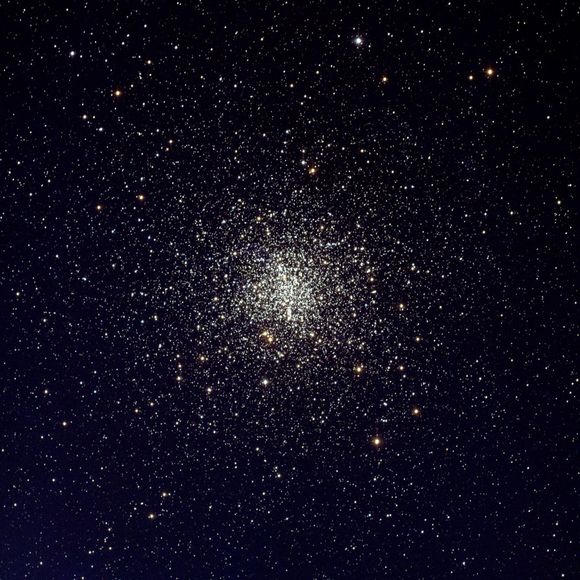
Globular Cluster: M4 in Scorpius ('The Scorpion') (Image Credit: NASA)

